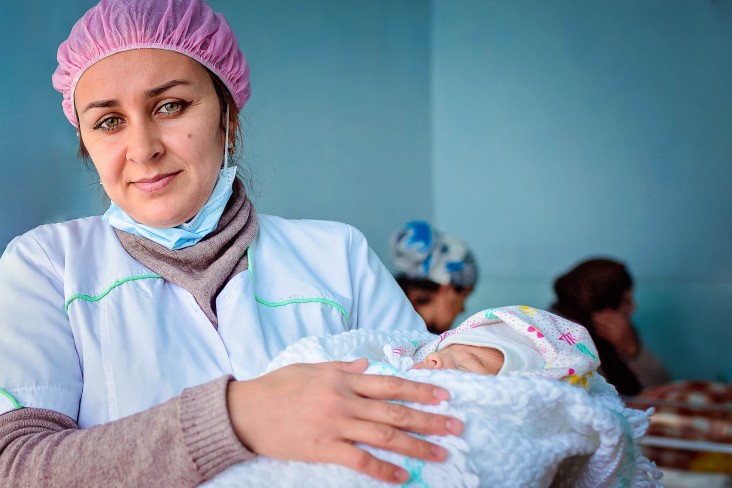Speeches Shim

Tajikistan’s health system faces a number of significant challenges, including a growing HIV/AIDS epidemic, high rates of tuberculosis, and persistent issues in maternal and child health. In addition to these, USAID also supports an inclusive society for individuals with disabilities. Tajikistan notably suffered a polio outbreak in 2010 that left many hundreds of children in need of disability services and rehabilitation.
Focused Interventions in HIV/AIDS Prevention and Treatment
Situated along the illicit drug transport corridor from Afghanistan, Tajikistan suffers from a growing HIV/AIDS epidemic, which is fueled largely by people who inject drugs and spread the disease to other intravenous drug users and their sexual partners.
USAID works closely with Tajikistan’s Ministry of Health to strengthen essential healthcare services. USAID programs expand access to comprehensive HIV/AIDS prevention, treatment, and care services for key populations and seek to reduce stigma and discrimination. USAID also focuses on strengthening the abilities of national and local institutions, non-governmental organizations, and individuals to more effectively lead the planning, delivery, and monitoring of quality services for key populations.
New Treatment for Tuberculosis Patients
Tajikistan has one of the world’s highest rates of multidrug-resistant TB (MDR-TB) and extensively drug-resistant TB (XDR-TB), which is fueled by a general lack of awareness of how TB spreads and fears of the stigma that accompanies a TB diagnosis.
USAID works with civilian and prison health officials to increase access to TB care and expand the use of patient-centered ambulatory treatment approaches. USAID also supports a rigorous program to build the skills and capacities of health providers, communities, and patients to understand and address treatment and care for TB and multidrug-resistant TB. Additionally, USAID is helping the Ministry of Health roll out new treatment regimens for MDR-TB, which reduces the treatment period from 24 to nine months, and new drugs capable of saving the lives of those with extremely drug-resistant TB.
In December 2017, the first cohort of XDR-TB patients completed the new, shorter treatment regimen, and everyone is fully cured of TB.
Better Care for Maternal Child Health
Maternal and child mortality rates in Tajikistan are the highest in the region. Although the maternal mortality rate is steadily decreasing and, in 2016, reached 25.2 deaths per 100,000 live births according to the Ministry of Health, this is compared to 95 per 100,000 live births in 2005 (Multi Indicator Cluster Survey) and 32 per 100,000 live births in 2008 (The World Bank data). According to the 2012 Demographic Health Survey (DHS), 79 percent of pregnant women see a health professional at least once for prenatal care, but only 13 percent received high-quality prenatal care that followed national protocols and standards. Nearly 10 percent of deliveries are not overseen by a skilled birth attendant. Only about 26 percent of women of reproductive age use modern birth control methods. Tajikistan has made significant progress in preventing child mortality. According to the 2012 DHS, the child mortality rate is 43 per 1,000 live births in Tajikistan. Most of these deaths occur during the first year of life – the infant mortality rate is 34 per 1,000 live births. More than 40 percent of the population does not have access to clean water, and only 20 percent consume water from a central water supply system. Up to 60 percent of intestinal diseases in Tajikistan are water-borne, accounting for 16 percent of deaths among children younger than five years old.
Results:
- USAID provided nutrition and maternal and child health education that targeted over 87,000 households. The percentage of women attending four or more antenatal visits increased from 52 to 81.7 percent and exclusive breastfeeding rates reached almost 90 percent.
- USAID revised and printed 60,000 booklets to promote health and nutrition for mothers and children during the critical “first 1000 days of life” period.
- Quality of care continued to improve at nine district hospitals, and improvement increases ranged between 15 percent and 70 percent across 131 quality improvement indicators.
- More than 500 full-time medical workers from state health facilities have been trained on a range of maternal and child health and nutrition issues.


Comment
Make a general inquiry or suggest an improvement.